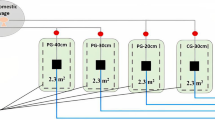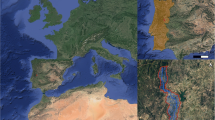Abstract
The study of low-cost techniques for the tertiary treatment of wastewater is of global interest; above all low-energy techniques that do not require the use of chemicals. In this study, a wastewater treatment technology based on the filtration by a zooplanktonic population (Daphnia magna) is studied in controlled laboratory and mesocosm experiments for different hydraulic retention times (HRT). The efficiency of the treatment is evaluated in terms of particle removal efficiency. From laboratory experiments, HRT over 12 h and Daphnia concentrations above 50 individuals l−1 guarantee a particle removal efficiency greater than 30 %. However, low HRT of 6 h would require Daphnia concentrations above 70 individuals l−1 in order to obtain a particle removal efficiency of 20 %. The minimum removal efficiency of 2 % was for HRT = 3 h, independent of the Daphnia concentration. In the mesocosm, the growth of Daphnia individuals enhanced Daphnia magna filtering rates and higher removal efficiencies than those in the laboratory for the same HRT range. In the mesocosm experiments E. coli concentrations were reduced to a maximum of 2 logarithmic units. A balance equation model is proposed to predict particle removal efficiencies for varying HRT.






Similar content being viewed by others
References
Adamsson M, Dave G, Forsberg L, Guterstam B (1998) Toxicity identification evaluation of ammonia, nitrite and heavy metals at the Stensund Wastewater Aquaculture Plant, Sweden
Arruda JA, Marzolf GR, Flauk RT (1983) The role of suspended sediments in the nutrition of zooplankton in turbid reservoirs. Ecology 64:1225–1235
Berger SA, Diehl S, Stibor H et al (2006) Water temperature and mixing depth affect timing and magnitude of events during spring succession of the plankton. Oecologia 150:643–654. doi:10.1007/s00442-006-0550-9
Biesinger KE, Christensen GM (1972) Effects of various metals on survival, growth, reproduction, and metabolism of daphnia magna. J Fish Res Board Canada 29:1691–1700. doi:10.1139/f72-269
Burns C (1969) The relationship between body size of filter-feeding Cladocera and the maximum size of particle ingested. Limnol Oceanogr 14:693–700
Chavez A, Jiménez R, Maya C (2004) Particle size distribution as a useful tool for microvial detection. Water Sci Technol 50:179–186
Degans H, Zöllner E, Gucht K et al (2002) Rapid Daphnia-mediated changes in microbial community structure: an experimental study. FEMS Microbiol Ecol 42:137–149. doi:10.1111/j.1574-6941.2002.tb01003.x
DeMott WR (1982) Feeding selectivities and relative ingestion rates of Daphnia and Bosmina. Limnol Oceanogr 27:518–527
Fu T, Xiao Q, Huang X, Fu J (2011) Report on sludge treatment and disposal market in China. http://www2.h2o-china.com/report/2011/2011wunireport
García-Mesa JJ, Poyatos JM, Delgado-Ramos F et al (2010) Water quality characterization in real biofilm wastewater treatment systems by particle size distribution. Bioresour Technol 101:8038–8045. doi:10.1016/j.biortech.2010.05.071
Garcia-Rodríguez A, Matamoros V, Fontàs C, Salvadó V (2014) The ability of biologically based wastewater treatment systems to remove emerging organic contaminants—a review. Environ Sci Pollut Res 21:11708–11728. doi:10.1007/s11356-013-2448-5
Gliwicz ZM (1990) Food thresholds and body size in Cladocerans. Nature 343:638–640
Honeyman BD, Santschi PH (1989) A Brownian pumping model for oceanic trace-metal scavenging-evidence from TH-isotopes. J Mar Res 47:951–992
Horn W (1981) Phytoplankton losses due to zooplankton grazing in a drinking water reservoir. Int Rev der gesamten Hydrobiol und Hydrogr 66:787–810
Jung D, Cho A, Zo YG et al (2009) Nutrient removal from polluted stream water by artificial aquatic food web system. Hydrobiologia 630:149–159. doi:10.1007/s10750-009-9788-7
Jürgens K, Gasol JM, Massana R, Pedrós-Alió C (1994) Control of heterotrophic bacteria and protozoans by Daphnia pulex in the epilimnion of Lake Ciso. Arch fur Hydrobiol 131:55–78
Kasprzak P, Lathrop RC, Carpenter SR (1999) Influence of different sized Daphnia species on chlorophyll concentration and summer phytoplankton community structure in eutrophic Wisconsin lakes. J Plankton Res 21:2161–2174. doi:10.1093/plankt/21.11.2161
Kim SR, Woo SS, Cheong EH, Ahn TS (2003) Nutrient removal from sewage by an artificial food web system composed of phytoplankton and Daphnia magna. Ecol Eng 21:249–258. doi:10.1016/j.ecoleng.2003.11.003
Knisley K, Geller W (1986) Selective feeding of four zooplankton species on natural lake phytoplankton. Oecologia 69:86–94
Laforsch C, Torllrian R (2004) Extreme helmet formation in Daphnia cucullata induced by small-scale turbulence. J Plankton Res 26:81–87
Leung J, Kumar M, Glatz P, Kind K (2011) Impacts of un-ionized ammonia in digested piggery effluent on reproductive performance and longevity of Daphnia carinata and Moina australiensis. Aquaculture 310:401–406. doi:10.1016/j.aquaculture.2010.11.015
Lin S, Jiang J, Yi X et al (2014) Decreasing excess biomass from municipal wastewater using an artificial food web system. J Environ Eng. doi:10.1061/(ASCE)EE.1943-7870.0000837
Maceda-Veiga A, Webster G, Canals O et al (2015) Chronic effects of temperature and nitrate pollution on Daphnia magna: is this cladoceran suitable for widespread use as a tertiary treatment? Water Res 83:141–152. doi:10.1016/j.watres.2015.06.036
Marquet R, Muhammad N, Vairavamoorthy K, Wheatley A (2007) Particle size distribution to assess the performance of trickling filters. Process Saf Environ Prot 85:99–103. doi:10.1205/psep.05194
Matamoros V, Sala L, Salvadó V (2012) Evaluation of a biologically-based filtration water reclamation plant for removing emerging contaminants: a pilot plant study. Bioresour Technol 104:243–249
Mujeriego R, Asano T (1999) The role of advanced treatment in wastewater reclamation and reuse. Water Sci Technol 40:1–9. doi:10.1016/S0273-1223(99)00479-5
Pau C, Serra T, Colomer J et al (2013) Filtering capacity of Daphnia magna on sludge particles in treated wastewater. Water Res 47:181–186. doi:10.1016/j.watres.2012.09.047
RD 1620/2007, de 7 de diciembre por el que se establece el régimen jurídico de la reutilización de las aguas depuradas [Spainsh Act of Parliament 1620/2007 of 7th December 2007 establishing the legal framework for reusing treated wastewater]. Boletín Ofic
Schalau K, Rinke K, Straile D, Peters F (2008) Temperature is the key factor explaining interannual variability of Daphnia development in spring: a modelling study. Glob Chang Biol 157:531–543
Serra T, Colomer J, Cristina X et al (2001) Evaluation of a laser in situ scattering instrument for measuring the concentration of phytoplankton, purple sulphur bacteria and suspended inorganic sediments in lakes. J Environ Eng 127:1023–1030
Serra T, Colomer J, Gacia E et al (2002) Effects of a turbid hydrothermal plume on the sedimentation rates in a karstic lake. Geophys Res Lett. doi:10.1029/2002GL015368
Serra T, Soler M, Julia R et al (2005) Behaviour and dynamics of a hydrothermal plume in Lake Banyoles, Catalonia, NE Spain. Sedimentology 52:795–808. doi:10.1111/j.1365-3091.2005.00611.x
Serra T, Colomer J, Pau C et al (2014) Tertiary treatment for wastewater reuse based on the Daphnia magna filtration—comparison with conventional tertiary treatments. Water Sci Technol 70:705–711. doi:10.2166/wst.2014.284
Seuront L, Yamazaki H, Souissi S (2004) Hydrodynamic disturbance and zooplankton swimming behavior. Zool Stud 43:376–387
Shiny K, Remani K, Nirmala E et al (2005) Biotreatment of wastewater using aquatic invertebrates, Daphnia magna and Paramecium caudatum. Bioresour Technol 96:55–58. doi:10.1016/j.biortech.2004.01.008
Straile D (2000) Meteorological forcing of plankton dynamics in a large and deep continental European lake. Oecologia 122:44–50. doi:10.1007/PL00008834
Straile D (2002) North Atlantic Oscillation synchronizes food-web interactions in central European lakes. Proc Biol Sci 269:391–395. doi:10.1098/rspb.2001.1907
Tóth G, Parpala L, Balogh C et al (2011) Zooplankton community response to enhanced turbulence generated by water-level decrease in Lake Balaton, the largest shallow lake in Central Europe. Limnol Oceanogr 56:2211–2222. doi:10.4319/lo.2011.56.6.2211
Von Sperling M (2007) Wastewater characteristics, treatment and disposal. IWA Publication, London, UK
Wickramarathna LN, Noss C, Lorke A (2014) Hydrodynamic trails produced by Daphnia: size and energetics. PLoS ONE. doi:10.1371/journal.pone.0092383
Acknowledgments
We thank Concepció Pau and Joan Colom for their assistance in the field work. This work was funded by the Consorci de la Costa Brava (CCB). We also thank Lluis Sala for his encouragement during the work.
Author information
Authors and Affiliations
Corresponding author
Rights and permissions
About this article
Cite this article
Serra, T., Colomer, J. The hydraulic retention time on the particle removal efficiency by Daphnia magna filtration on treated wastewater. Int. J. Environ. Sci. Technol. 13, 1433–1442 (2016). https://doi.org/10.1007/s13762-016-0985-4
Received:
Revised:
Accepted:
Published:
Issue Date:
DOI: https://doi.org/10.1007/s13762-016-0985-4




